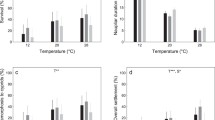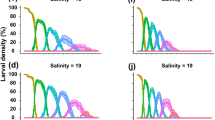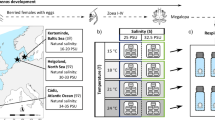Abstract
The successful invasion of a non-native species depends on several factors, including initial colonization and establishment of a self-sustaining population. Populations of the non-native paddle crab Charybdis japonica were first recognized in the Waitemata Harbour, Auckland, New Zealand in 2000, most likely arriving in ballast waters of an Asian merchant vessel. A survey completed in 2003 found C. japonica throughout the Waitemata Harbour, and further sampling in 2009 has revealed several well established populations in estuaries up to 70 km from the putative invasion point. As the potential for further establishment of C. japonica beyond this area may depend on the temperature and salinity tolerances of their free swimming larvae, we quantified the survival of newly-hatched Stage 1 C. japonica zoeae subjected to temperatures ranging from 11 to 43°C or salinities from 5 to 45‰ in the laboratory. Upon hatching, replicate C. japonica zoeae were directly transferred from 21°C and 34.6‰ seawater to either an experimental temperature or salinity level. Behaviour and death rates of the larvae were monitored over a 24 h period in the absence of food. Comparisons of zoeal survival rates to historical sea surface temperatures and salinities show that C. japonica Stage 1 zoeae tolerate a broad range of temperatures and salinities and could survive natural conditions throughout New Zealand. This gives C. japonica the potential to invade many other New Zealand estuaries and harbours.




Similar content being viewed by others
References
Ai-Yun D, Yang S (1991) Crabs of the China Seas. Springer, Berlin
Anger K (1991) Effects of temperature and salinity on the larval development of the Chinese mitten crab Eriocheir sinensis. Mar Ecol Progr Ser 72:103–110
Anger K (1998) Patterns of growth and chemical composition in decapod crustacean larvae. Invertebr Reprod Dev 33:159–176
Anger K (2001) The biology of decapod crustacean larvae. Crustacean Issues, vol 14. A.A. Balkema, Lisse
Anger K, Spivak E, Luppi T (1998) Effects of reduced salinities on development and bioenergetics of early larval shore crab, Carcinus maenas. J Exp Mar Biol Ecol 220:287–304
Auckland Regional Council (2009) Auckland Regional Viewer. http://maps.auckland.govt.nz/aucklandregionviewer/?widgets=HYDROTEL#. Accessed 20 July 2009
Baylon J, Suzuki H (2007) Effects of changes in salinity and temperature on survival and development of larvae and juveniles of the crucifix crab Charybdis feriatus (Crustacea: Decapoda: Portunidae). Aquaculture 269:390–401
Bravo MA, Cameron B, Metaxas A (2007) Salinity tolerance in the early larval stages of Carcinus maenas (Decapoda, Brachyura), a recent invader of the Bras D’Or Lakes, Nova Scotia, Canada. Crustaceana 80:475–490
Brett JR (1979) Environmental factors and growth. In: Hoar WS, Randall DJ, Brett JR (eds) Fish physiology, vol VIII. Academic Press, London, pp 599–675
Brodie RJ, Styles R, Borgianini S, Godley J, Butler K (2007) Larval mortality during export to the sea in the fiddler crab Uca minax. Mar Biol 152:1283–1291
Charmantier G, Charmantier-Daures M (1991) Ontogeny of osmoregulation and salinity tolerance in Cancer irroratus: elements of comparison with C. borealis (Crustacean, Decapoda). Biol Bull 180:125–134
Charmantier G, Haond C, Lignot J, Charmantier-Daures M (2001) Ecophysiological adaptation to salinity throughout a life cycle: a review in homarid lobsters. J Exp Biol 204:967–977
Charmantier G, Giménez L, Charmantier-Daures M, Anger K (2002) Ontogeny of osmoregulation, physiological plasticity, and export strategy in the grapsid crab Chasmagnathus granulata (Crustacea, Decapoda). Mar Ecol Prog Ser 229:185–194
Cieluch U, Anger K, Aujoulat F, Buchholz F, Charmantier-Daures M, Charmantier G (2004) Ontogeny of osmoregulatory structures and functions in the green crab Carcinus maenas (Crustacea, Decapoda). J Exp Biol 207:325–336
deRivera CE, Hitchcock NG, Teck SJ, Stevens BP, Hines AH, Ruiz GM (2007) Larval development rate predicts range expansion of an introduced crab. Mar Biol 150:1275–1288
Epifanio CE, Dittel AI, Park S, Schwalm S, Fouts A (1998) Early life history of Hemigrapsus sanguineus, a non-indigenous crab in the Middle Atlantic Bight (USA). Mar Ecol Prog Ser 170:231–238
Gilman S (2006) Life at the edge: an experimental study of a poleward range boundary. Oecologia 148:270–279
Giménez L (2002) Effects of prehatching salinity and initial larval biomass on survival and duration of development in the zoea 1 of the estuarine crab, Chasmagnathus granulata, under nutritional stress. J Exp Mar Biol Ecol 270:93–110
Giménez L, Torres G (2002) Larval growth in the estuarine crab Chasmagnathus granulata: the importance of salinity experienced during embryonic development, and the initial larval biomass. Mar Biol 141:877–885
Gust N, Inglis GJ (2006) Adaptive multi-scale sampling to determine an invasive crab’s habitat usage and range in New Zealand. Biol Invasions 8:339–353
Hai TN, Hassan AB, Law AT, Shazili NAM (1998) Effects of reduced water salinity on juveniles of the mud crab Scylla serrata. International Forum on the Culture of Portunid Crabs, 1–4 December, 1998, Boracay, Philippines, Asian Fisheries Society, Quezon City, Philippines p 57
Heath RA (1976) Broad classification of New Zealand inlets with emphasis on residence times. N Z J Mar Freshwater Res 10:429–444
Hong-Yu L, Lu-Qing P, Debin Z (2008) Effects of salinity and biogenic amines, hemolymph osmotic pressure, and activity of gill’s Na+/K+-ATPase in Charybdis japonica (Crustacea, Decapoda). J World Aquaculture Soc 39:812–820
Jiang X, Wang C (2004) Effects of diet condition on survival and metamorphosis of Charybdis japonica larvae. Chin J App Ecol 15:173–175
Kolar CS, Lodge DM (2001) Progress in invasion biology: predicting invaders. Trends Ecol Evol 78:199–204
Lough GR (1976) Larval dynamics of the Dungeness crabs, Cancer magister, off the central Oregon coast. Fish Bull US 74:353–375
Morgan SG (1995) Life and death in the plankton: larval mortality and adaption. In: McEdward LR (ed) Ecology of marine invertebrate larvae. CRC Press, Boca Raton, pp 279–321
Pechenik JA (1987) Environmental influences on larval survival and development. In: Giese AC, Pearse JS, Pearse VB (eds) Reproduction of marine invertebrates, vol 9. Blackwell, Palo Alto, pp 551–608
Rudnick DA, Halat KM, Resh VH (2000) Distribution, ecology and potential impacts of the Chinese mitten crab (Eriocheir sinensis) in San Francisco Bay. Water resources center contribution, vol 26. University of California, Berkeley
Rumrill SS (1990) Natural mortality of marine invertebrate larvae. Ophelia 32:163–198
Salinger MJ, Hicks DM (1990) The scenarios. In: Climate change: impacts on New Zealand—implications for the environment, economy and society. Ministry for the Environment, Wellington pp 12–18
Sanford E, Holzman SB, Haney RA, Rand DM, Bertness MD (2006) Larval tolerance, gene flow, and the northern geographic range limit of fiddler crabs. Ecology 87:2882–2894
Simberloff D (2009) We can eliminate invasions or live with them: successful management projects. Biol Invasions 11:149–157
Storch D, Santelices P, Barria J, Cabeza K, Pörtner HO, Fernández M (2009) Thermal tolerance of crustacean larvae (zoea I) in two different populations of the kelp crab Taliepus dentatus (Milne-Edwards). J Exp Biol 212:1371–1376
Sulkin SD, Mojica E, McKeen GL (1996) Elevated summer temperature effects on megalopal and early juvenile development in the Dungeness crab, Cancer magister. Can J Fish Aquat Sci 53:2076–2079
Taylor HH, Seneviratna D (2005) Ontogeny of salinity tolerance and hyper-osmoregulation by embryos of the intertidal crabs Hemigrapsus edwardsii and Hemigrapsus crenulatus (Decapoda, Grapsidae): survival of acute hyposaline exposure. Comp Biochem Physiol Mol Integr Physiol 140:495–505
Torres G, Gimenez L, Anger K (2002) Effects of reduced salinity on the biochemical composition (lipid, protein) of zoea 1 decapod crustacean larvae. J Exp Mar Biol Ecol 277:43–60
Vander Zanden MJ, Olden JD (2008) A management framework for preventing the secondary spread of aquatic invasive species. Can J Fish Aquat Sci 65:1512–1522
Vaughn D, Allen JD (2010) The peril of the plankton. Integr Comp Biol Advance Access 1–19. doi: 10.1093/icb/icq037
Weimin J, Tianxiang M, Ruisheng C, Sheng W (1998) Diet of Charybdis japonica (A. Milne-Edwards) and Portunus trituberculatus (Miers) in the Bohai Sea. Mar Fish Res/Haiyang Shuichan Yanjiu 19:53–59
Williams BL (1986) Flushing time calculations for the Upper Waitemata Harbour, New Zealand. N Z J Mar Freshwater Res 20:455–465
Yatsuzuka K (1952) The metamorphosis and growth of the larva of Charybdis japonica A. Milne Edward. Bull Jpn Soc Sci Fish 17:353–358
Acknowledgments
This research was supported by a Fulbright New Zealand Graduate scholarship and University of Auckland Fulbright scholarship to A.E.F. N.V.G was supported by the IFM-Geomar in Kiel, Germany with the financial support from the Mercator Stiftung, Universitätsstiftung Kiel and Vereinigung von Freunden und Förderern der Goethe-Universität Frankfurt am Main. M. Birch assisted with project development, and A. Fukunaga provided statistical and editorial advice. Thank you to the various governmental councils and research organizations for providing us with the historical temperature and salinity data. We gratefully acknowledge D. Simberloff and an anonymous reviewer for comments which significantly improved the manuscript.
Author information
Authors and Affiliations
Corresponding author
Electronic supplementary material
Below is the link to the electronic supplementary material.
Rights and permissions
About this article
Cite this article
Fowler, A.E., Gerner, N.V. & Sewell, M.A. Temperature and salinity tolerances of Stage 1 zoeae predict possible range expansion of an introduced portunid crab, Charybdis japonica, in New Zealand. Biol Invasions 13, 691–699 (2011). https://doi.org/10.1007/s10530-010-9860-2
Received:
Accepted:
Published:
Issue Date:
DOI: https://doi.org/10.1007/s10530-010-9860-2




